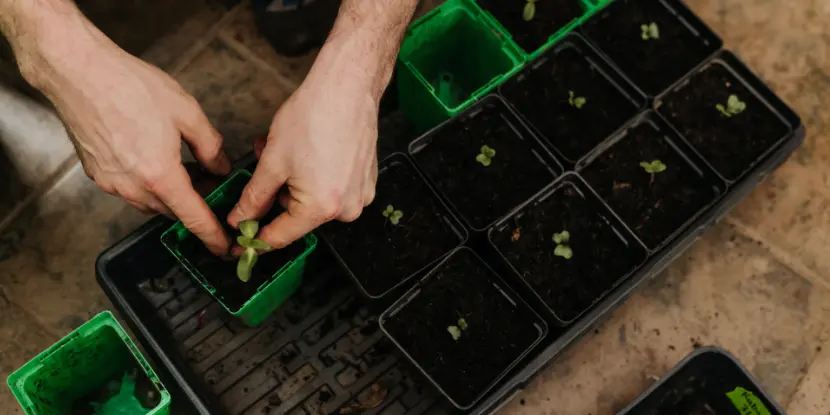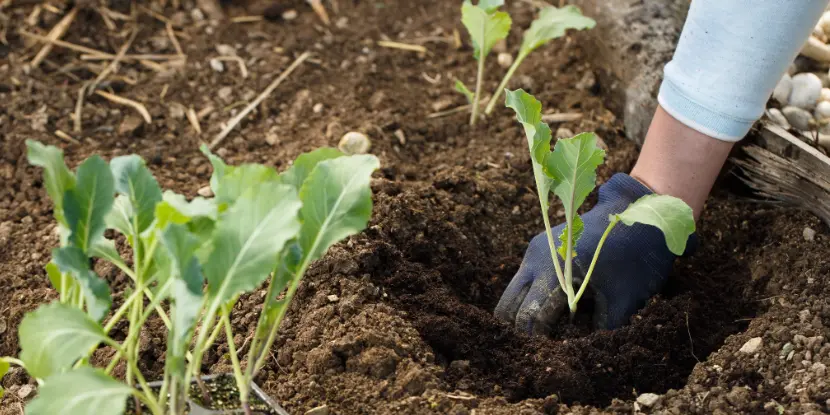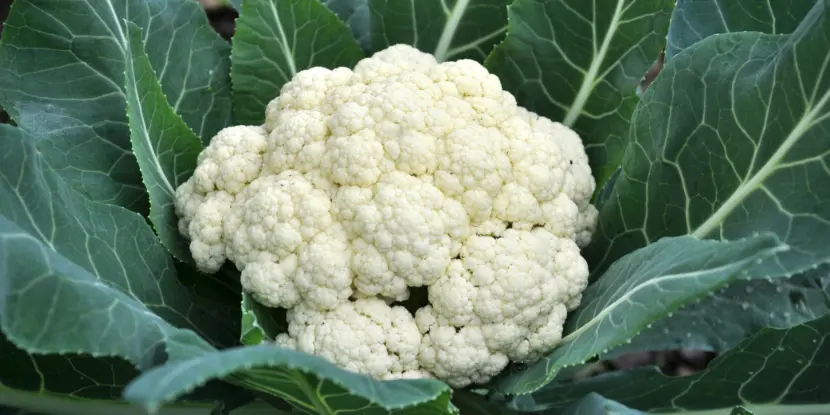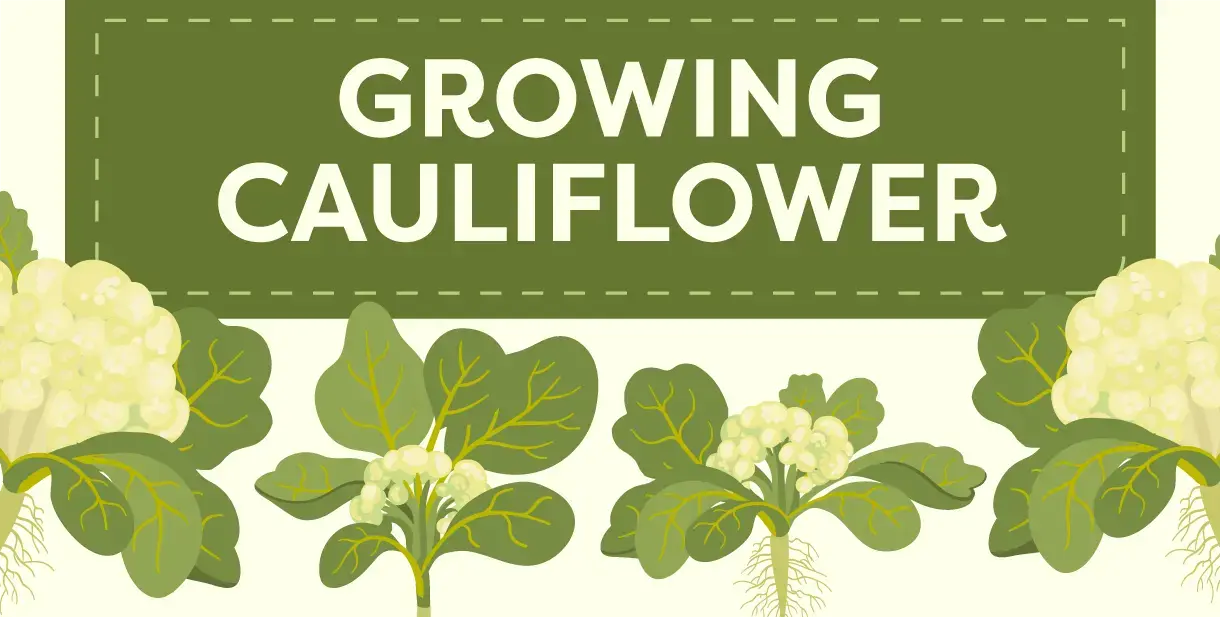What’s the world’s most popular edible flower?
The cauliflower, of course!
Dad jokes aside, there are many good reasons to grow this tasty brassica in your Southern California garden.
- Cauliflower is an easy-to-grow, low-maintenance crop
- It’s a nutritional powerhouse, packed with vitamins and fiber
- You can enjoy the whole plant — leaves, stems, and all!
- There are endless ways to prepare it.
Origins of the Cauliflower
Cauliflower belongs to the Brassicaceae, or mustard family, which includes broccoli, kale, cabbage, and Brussels sprouts. It was first cultivated in the Mediterranean region around the 6th century BC, primarily for its flavor and culinary versatility. Not until the 19th century, with the rise of food chemistry and science, did we know about its nutritional wonders.
The French adopted the bumpy vegetable in the 16th century and called it “chou-fleur,” meaning “cabbage flower.”
It was introduced to England in the early 17th century, where it became a favorite in high society meals.
Over the centuries, selective breeding has led to many varieties, each adapted to specific growing conditions and culinary applications.

Three brilliant varieties of cauliflower.
Best Cauliflower Varieties for Southern California
- Snowball: traditional white variety; matures in ≈ 55 days
- Snow Crown: an adaptable that needs less water and matures in ≈ 58 days
- Graffiti: has purple colored heads; matures in ≈ 75 days
- Romanesco: has chartreuse green conical-shaped heads, matures in about 70 days
- Cheddar: drought-tolerant and visually appealing with its orange heads; matures ≈ 70 days.
- Early White: known for its resilience; matures in ≈ 60 days.
- Amazing Graze: a unique variety that can withstand dry conditions, maturing in ≈ 65 days.
Starting Cauliflower from Seed
Buy your seeds from a reputable supplier (like Anawalt!). Plant the seeds indoors 4–6 weeks before the last expected frost. Use seed trays or small pots filled with a high-quality seed-starting mix.
- Cauliflower can be grown in spring and fall. Summer temperatures can make it bolt (go to seed) prematurely.
- In areas with mild winters, you can also grow cauliflower as a winter crop.
Follow these steps to get your seeds off to the best start:
- Moisten the soil before planting the seeds; use a spray bottle or fine mist sprinkler to avoid washing away the soil.
- Plant the seeds 1/4 inch deep and cover lightly with more of your starting mix.
- Mist daily until germination occurs in about 7–14 days.
- Place trays or pots in a warm spot out of direct sunlight.
- Once seedlings have emerged, move them into a sunny area for 12–16 hours daily.

Cauliflower seedlings growing in small containers.
Transplanting Cauliflower to the Garden
Seedlings are ready for transplanting when they’re 4–6 weeks old and have developed several true leaves.
- Gradually expose seedlings to outdoor conditions over a week to acclimate them.
- Choose a sunny spot with well-draining soil.
- Space the plants 18–24 inches apart to allow room for growth.
Dig holes slightly larger than the root balls and plant the seedlings at the same depth as in their pots. Water them well after transplanting to help them settle in.

A gardener transplants cauliflower seedlings to the garden.
Soil Requirements
Cauliflower loves rich, well-draining soil with a pH level between 6.0 and 7.0. To enhance fertility and structure before planting, amend the soil with compost or well-rotted manure.
- Ensure the soil is high in organic matter and nutrients.
- Avoid waterlogged conditions, which can lead to root rot.
- Test the soil and adjust the pH if necessary, using lime (to raise pH) or sulfur (to lower pH).
Light
- Cauliflower should receive at least 6 hours of direct sunlight each day.
- Full sun is best, but cauliflower can tolerate partial shade in hotter climates.
- Provide shade cloth if temperatures exceed 75°F to prevent bolting.
Temperature
- Cauliflower prefers cooler temperatures between 60-70°F.
- It can tolerate mild frosts, making it an excellent cool-season crop.
- In Southern California, you can grow cauliflower in both fall and spring.

A cauliflower head begins to form.
Watering
- Keep the soil moist but not soggy.
- Cauliflower needs about 1 inch of water per week from rain or irrigation.
- Water deeply and infrequently to encourage deep root growth.
Fertilizing
- Use a balanced fertilizer, such as 10-10-10, at planting time.
- Side-dress the plants with additional fertilizer every 4–6 weeks during the growing season.
- Avoid high-nitrogen fertilizers that can lead to leafy growth instead of head development.
Pest & Disease Control
Common pests include aphids, cabbage worms, and flea beetles. The most common diseases are clubroot, black rot, and downy mildew.
- Practice crop rotation to prevent the buildup of pests and diseases in the soil.
- Use row covers to protect young plants from pests.
- Handpick pests or apply organic sprays like neem oil.
- Keep plants healthy by providing optimal growing conditions.

A gardener checks a cauliflower plant for pests.
Preventing Bolting
Cauliflower is a cool-season crop that can bolt or prematurely start producing flowers when exposed to high temperatures. Take these steps to prevent bolting:
- Choose heat-tolerant varieties like Snow Crown and Cheddar.
- Plant in partial shade or use shade cloth during hot spells.
- Mulch around plants to keep the soil cool.
- Harvest heads without delay when they reach maturity.
Harvesting
Harvest cauliflower heads while they’re still tight and firm. They’re usually between 6 and 12 inches in diameter, depending on the variety.
- Cut off the entire head with a sharp knife at the base of its stem.
- If you notice yellow

A large cauliflower head ready for harvest.
Harvesting Cauliflower
Harvesting cauliflower at the right time ensures the best flavor and texture. The heads should be compact, firm, and white (or colored, depending on the variety).
- Harvest when the heads are 6–8 inches in diameter.
- Cut the heads off the plant with a sharp knife, leaving some leaves attached to protect them.
- Store cauliflower in the refrigerator for up to two weeks.
5 Ways to Prepare Your Cauliflower
- Cauliflower rice: finely chop or grate the cauliflower and use it as a low-carb alternative to rice.
- Cauliflower pizza crust: replace traditional flour crust with one made from ground cauliflower.
- Roasted cauliflower steaks: cut thick cauliflower slices and roast them in the oven for an easy, flavorful vegetarian main dish.
- Cauliflower mash: steam or boil cauliflower florets and mash them with butter and seasonings for a healthier twist on mashed potatoes.
- Cauliflower buffalo “wings”: coat roasted cauliflower florets in buffalo sauce for a tasty and healthier version of the popular appetizer.

Cauliflower can be prepared in so many scrumptious ways — roasting, for example.
FAQs: Growing Cauliflower
Q: How long does it take to grow cauliflower?
Depending on the variety, Cauliflower typically takes 50–100 days from transplanting to harvest.
Q: Can I grow cauliflower in containers?
Yes, cauliflower can be grown in containers with at least 12 inches of depth and width.
Q: What makes cauliflower heads turn yellow?
Too much sun exposure can cause yellowing. To protect the heads from sunlight, blanch them by tying the outer leaves over them.
Q: What should I do if my cauliflower heads are small?
Small cauliflower heads may result from inadequate nutrients, poor watering, or insufficient sunlight. To promote optimal head development, provide proper fertilization, consistent irrigation, and at least 6 hours of direct sunlight daily.
Q: How can I tell if my cauliflower is ready to harvest?
The heads will be firm, compact, and have reached a size of 6–8 inches in diameter. The head color should be bright white (or the appropriate color for the variety).
Q: Can I eat the leaves of the cauliflower plant?
Cauliflower leaves are edible and can be used in salads, soups, or sautéed as a side dish. They offer similar nutritional benefits to the florets.
Q: What pests should I watch for when growing cauliflower?
Aphids, cabbage worms, and flea beetles are common pests. Regularly inspect your plants and take immediate action if you notice an infestation.
Q: Is it possible to grow cauliflower from store-bought cauliflower?
Yes, but it’s not the most reliable method. We recommended starting from seeds or seedlings from a nursery.

